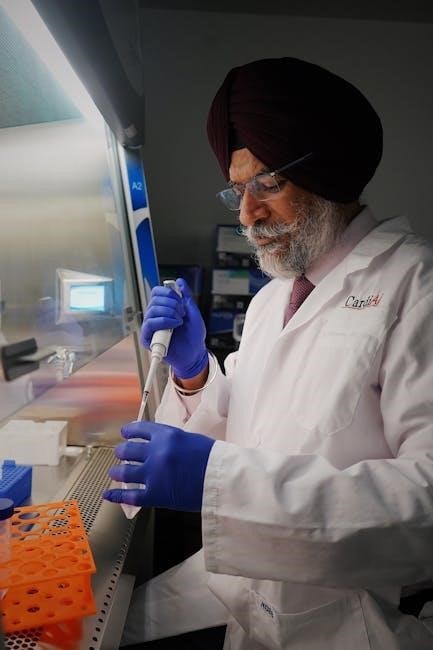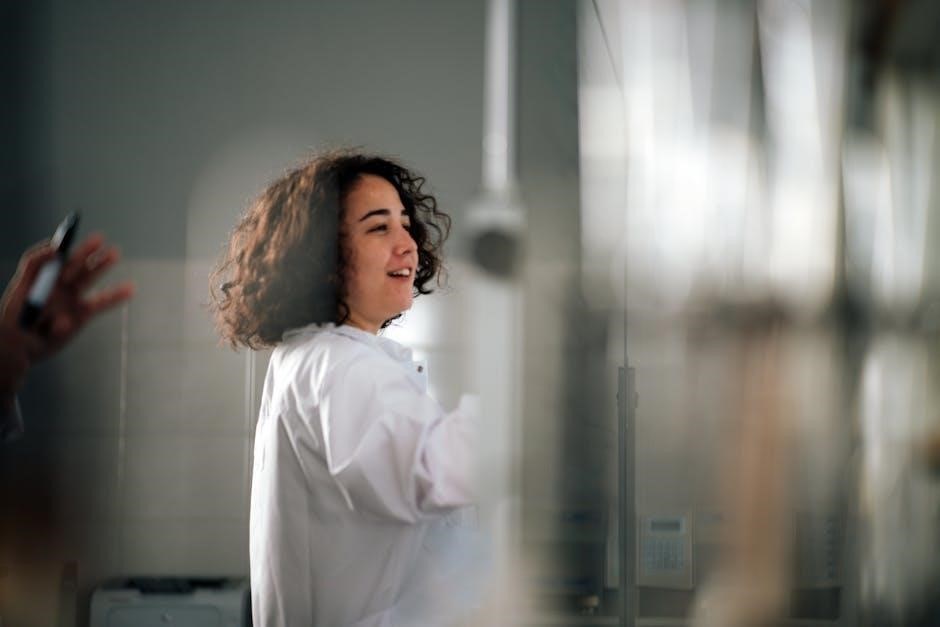Genetics is the study of heredity, focusing on how genes, DNA, and traits are passed through generations. It explores the fundamental principles of biological inheritance, enabling us to understand genetic disorders, evolutionary processes, and biotechnological advancements. This field is essential for medicine, agriculture, and personalized healthcare, offering insights into the building blocks of life and disease.
1.1 Definition and Importance of Genetics
Genetics is the scientific study of heredity, focusing on how genes, DNA, and traits are passed from one generation to the next. It examines the storage, replication, and transmission of biological information. The importance of genetics lies in its ability to explain inheritance patterns, diagnose genetic disorders, and improve agricultural crops. Understanding genetics is crucial for advancements in medicine, biotechnology, and personalized healthcare, making it a cornerstone of modern biology and a key tool for addressing health and environmental challenges.
1.2 Key Concepts: Genotype, Phenotype, and Heredity
Genotype refers to the genetic makeup of an organism, while phenotype describes its physical and behavioral traits. Heredity explains how genes are passed from parents to offspring. The genotype determines the phenotype, influenced by dominant and recessive alleles. Understanding these concepts is fundamental to genetics, as they explain variation, inheritance patterns, and evolutionary processes. These principles form the basis for predicting traits, diagnosing genetic disorders, and advancing biotechnological applications.
Mendelian Genetics
Mendelian genetics focuses on Gregor Mendel’s laws of segregation and independent assortment. These principles explain how genes are inherited, forming the basis of genetic prediction.
2.1 Laws of Segregation and Independent Assortment
Mendel’s Laws of Segregation and Independent Assortment form the foundation of genetics. The Law of Segregation states that alleles separate during gamete formation, while the Law of Independent Assortment explains that genes for different traits segregate independently. These principles, discovered through pea plant experiments, predict the probability of trait inheritance and are fundamental for constructing Punnett squares to analyze genetic crosses.
2.2 Punnett Squares and Probability in Genetics
Punnett squares are tools used to predict the genetic outcomes of crosses. By arranging alleles from each parent, they visualize gamete combinations, helping determine trait probabilities. For monohybrid crosses, they show dominant and recessive allele interactions. In dihybrid crosses, they reveal independent assortment patterns. Probability calculations, such as 75% dominant phenotypic ratios, are derived from these squares, making them essential for understanding genetic inheritance and counseling.
2.3 Monohybrid vs. Dihybrid Crosses
A monohybrid cross involves one genetic trait, such as seed color, and examines the inheritance of two alleles. Dihybrid crosses, in contrast, involve two traits, like seed color and shape, and analyze the inheritance of four alleles. Monohybrid crosses yield a 3:1 phenotypic ratio, while dihybrid crosses produce a 9:3:3:1 ratio due to independent assortment. These crosses are fundamental for understanding Mendelian inheritance patterns and predicting genetic outcomes in breeding experiments.
DNA and Genes
DNA is the genetic blueprint, storing biological instructions. Genes are DNA segments controlling traits and guiding protein synthesis, crucial for inheritance and cellular functions.
3.1 Structure and Function of DNA
DNA (deoxyribonucleic acid) is a double-stranded helix made of nucleotides, each containing a sugar, phosphate, and nitrogenous base (adenine, thymine, cytosine, guanine). Base pairing (A-T, C-G) ensures stability. DNA’s primary function is storing genetic information, enabling replication and transmission of traits. It dictates protein synthesis through transcription and translation, following the Central Dogma. Mutations in DNA can alter genetic instructions, impacting inheritance and evolution.
3.2 The Central Dogma: DNA to Protein
The Central Dogma outlines the flow of genetic information: DNA is transcribed into RNA, which is then translated into proteins. DNA serves as the template for transcription, producing mRNA. This mRNA travels to ribosomes, where tRNA molecules match codons to specific amino acids. The sequence of amino acids forms a polypeptide chain, folding into a functional protein. This process is fundamental to gene expression, enabling organisms to synthesize proteins essential for life. Understanding the Central Dogma is crucial for studying genetic inheritance and molecular biology.
3.3 Genes vs. Alleles
A gene is a segment of DNA encoding a specific trait, while an allele is a variant of that gene. Genes are located on chromosomes and determine heritable traits. Alleles differ in their DNA sequence and can result in different expressions of a trait. For example, one allele might code for tall stature (B), while another codes for short stature (b). Multiple alleles can exist, but only two are inherited. Understanding genes and alleles is key to grasping genetic variation, inheritance patterns, and the basis of natural diversity in populations.

Gene Expression and Regulation
Gene expression involves the translation of genetic information into proteins, regulating traits. Environmental factors like diet, stress, and hormones influence gene activity, shaping phenotypes without altering DNA.
4.1 From DNA to RNA: Transcription
Transcription is the first step in gene expression, converting DNA into RNA. RNA polymerase reads a gene’s DNA sequence, synthesizing a complementary RNA strand. This process occurs in the nucleus, initiating protein production. RNA carries genetic information to ribosomes for translation, ensuring accurate trait expression. Environmental factors can influence transcription rates, affecting gene activity and phenotypic outcomes. Understanding transcription is crucial for studying gene regulation and its impact on cellular function and disease.
4.2 RNA to Protein: Translation
Translation converts mRNA into proteins, occurring on ribosomes. Ribosomes read mRNA codons, matching them with tRNA anticodons. Each tRNA carries a specific amino acid, linking them to form polypeptide chains. This process is essential for creating enzymes, structural proteins, and other vital molecules. Environmental factors like nutrition and stress can influence translation efficiency, impacting protein production and function; Understanding translation is key to grasping gene expression and its role in health and disease.
4.3 Environmental Factors Influencing Gene Expression
Environmental factors significantly impact gene expression by altering how genes are interpreted and executed. Diet, temperature, stress, and exposure to toxins can influence epigenetic modifications, such as DNA methylation and histone acetylation, which regulate gene activity. These changes can activate or silence specific genes without altering the DNA sequence. For example, environmental stressors may trigger the expression of stress-response genes, while nutritional deficiencies can affect metabolic pathways; Understanding these interactions is crucial for studying disease susceptibility, evolutionary adaptation, and developing personalized therapies.

Genetic Disorders
Genetic disorders arise from mutations or inherited traits, affecting gene function and causing conditions like cystic fibrosis, sickle cell anemia, and Down syndrome. They impact health significantly.
5.1 Types of Genetic Disorders
Genetic disorders are categorized into chromosomal, monogenic, polygenic, and mitochondrial types. Chromosomal disorders, like Down syndrome, result from chromosome number or structure abnormalities. Monogenic disorders, such as cystic fibrosis and sickle cell anemia, are caused by mutations in single genes. Polygenic disorders, like heart disease and diabetes, involve multiple genes and environmental factors. Mitochondrial disorders stem from mutations in mitochondrial DNA, affecting energy production. Understanding these types aids in diagnosis, treatment, and genetic counseling, providing insights into inheritance patterns and disease management strategies.
5.2 Cystic Fibrosis, Sickle Cell Anemia, and Other Common Disorders
Cystic fibrosis and sickle cell anemia are prominent genetic disorders caused by specific gene mutations. Cystic fibrosis results from a mutation in the CFTR gene, leading to respiratory and digestive issues. Sickle cell anemia is caused by a hemoglobin mutation, causing red blood cells to deform. Both are autosomal recessive disorders, requiring two defective alleles for manifestation. Other common disorders include Tay-Sachs disease and phenylketonuria, caused by enzyme deficiencies. These conditions highlight the importance of genetic testing and counseling for early diagnosis and management.
5.3 Genetic Testing and Counseling
Genetic testing involves analyzing DNA to identify gene mutations or chromosomal abnormalities. It is used to diagnose disorders, determine carrier status, or assess prenatal risks. Techniques include DNA sequencing and karyotyping. Genetic counseling provides guidance on test results, helping individuals understand risks and make informed decisions. It involves discussing family history, inheritance patterns, and reproductive options. Counseling supports individuals in managing genetic risks and navigating emotional and ethical implications. This process is crucial for individuals and families facing genetic disorders, offering clarity and personalized care.

Modern Genetics Techniques
Modern genetics techniques, such as CRISPR and gene editing, enable precise DNA modifications. These tools revolutionize medicine, agriculture, and biotechnology by advancing genetic engineering and research.
6.1 CRISPR and Gene Editing
CRISPR (Clustered Regularly Interspaced Short Palindromic Repeats) is a revolutionary gene-editing tool enabling precise modifications to DNA sequences. It uses a guide RNA to locate specific genes and an enzyme like Cas9 to cut DNA, allowing researchers to add, remove, or replace genetic material. This technology has transformed genetic research, offering potential treatments for genetic disorders, improving crop resilience, and advancing cancer therapies. Its applications are vast, ranging from basic science to clinical medicine, making it a cornerstone of modern genetics.
6.2 Genetic Engineering and Biotechnology
Genetic engineering involves manipulating genes to create desired traits in organisms. Biotechnology applies these techniques to develop products like medicines, crops, and enzymes. Tools such as recombinant DNA technology and transgenic organisms enable advancements in agriculture, medicine, and environmental science. For instance, pest-resistant crops and insulin production exemplify its practical applications. Ethical considerations and safety assessments are crucial as biotechnology continues to transform industries, offering solutions to global challenges while raising questions about its societal impact.
6.3 Advances in Genetic Research
Recent advancements in genetic research have revolutionized our understanding of genes and their functions. CRISPR-Cas9 technology has emerged as a groundbreaking tool for precise gene editing, enabling the treatment of genetic disorders like cystic fibrosis and sickle cell anemia. Additionally, the development of precision medicine allows personalized treatments based on an individual’s genetic makeup. Genome sequencing has become faster and more affordable, aiding in the discovery of genetic markers for diseases. These innovations are paving the way for new therapies and a deeper understanding of human biology, while raising important ethical considerations.

Study Tips and Resources
Utilize genetics study guides, PDF notes, and practice questions to master key concepts. Create flashcards for vocabulary and solve Punnett squares regularly for better understanding.
Focus on Mendelian inheritance and DNA structure. Join study groups and review lecture materials to reinforce learning. Explore online resources for visual aids and summaries.
7.1 Key Vocabulary for Genetics
Mastering key vocabulary is crucial for understanding genetics. Essential terms include heredity (trait transmission), gene (DNA segment encoding traits), and DNA (genetic material). Genotype refers to genetic makeup, while phenotype describes physical traits. Allele variants influence traits, with dominant and recessive interactions shaping outcomes. Terms like heterozygous and homozygous describe allele combinations. Understanding codominance and incomplete dominance aids in predicting trait expression. These terms form the foundation for advanced genetic concepts and problem-solving.
7.2 Recommended Study Materials and PDF Guides
Enhance your genetics study with free PDF guides covering essential topics like DNA structure, inheritance patterns, and genetic disorders. These organized notes provide clear overviews, making complex concepts accessible. Download lecture notes, workbooks, and study guides for in-depth learning. Resources like “Genetics Workbook” and “Mendelian Genetics Concepts” offer comprehensive reviews. Utilize these materials to grasp key principles and prepare for exams effectively. They are invaluable for structured and efficient studying.
7.3 Practice Questions and Problem-Solving Strategies
Master genetics with practice questions and strategic problem-solving techniques. Utilize multiple-choice exams covering alleles, Punnett squares, and Mendelian inheritance. Solve problems by breaking them into manageable steps, identifying key concepts, and applying genetic laws. Use diagrams to visualize crosses and outcomes. For exam preparation, practice timed sessions and review mistakes to improve understanding. Focus on interpreting pedigree charts and calculating probabilities. These strategies enhance critical thinking and ensure proficiency in genetic analysis and problem-solving.

Leave a Reply
You must be logged in to post a comment.